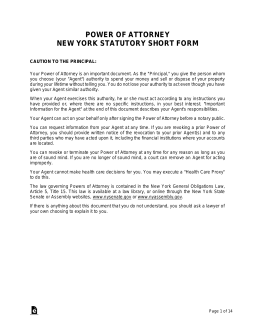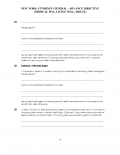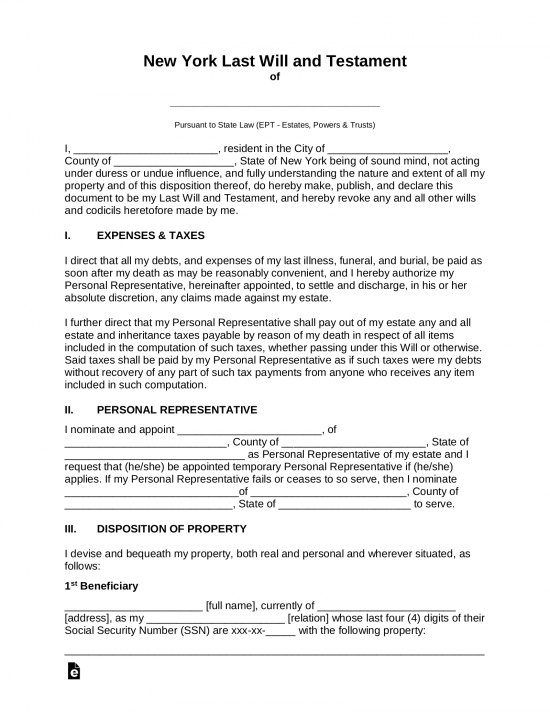Updated January 18, 2024
A New York durable statutory power of attorney allows a person to hand over the power to handle their finances to someone else, and remains valid during their lifetime. The person giving power (“principal”) can choose to give limited or broad powers to their selected individual (“agent”). The term “durable” is in reference to the form remaining valid even if the principal should become incapacitated or not mentally able to think for themselves (such as from a condition like Alzheimer’s Disease). After meeting the signing requirements, the agent can begin acting on behalf of the principal and must present the form at each occurrence.
Versions (3)
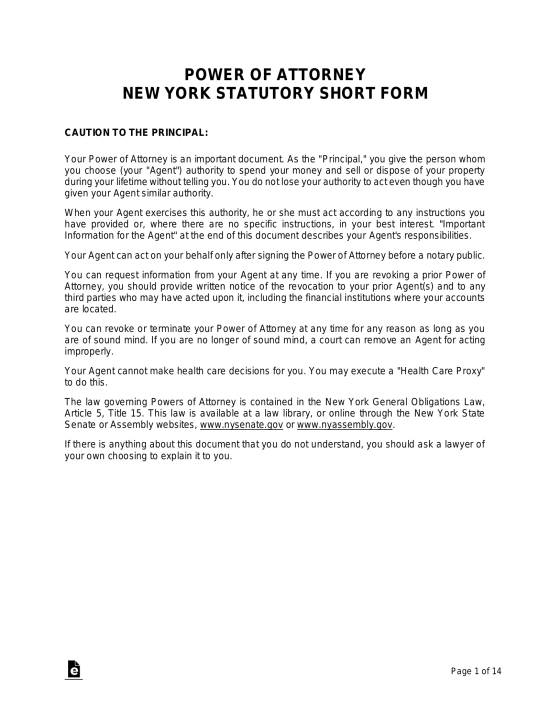 Standard Version (Statutory Short-Form)
Standard Version (Statutory Short-Form)
Download: PDF, MS Word, OpenDocument
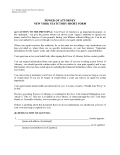 New York State BAR Durable Power of Attorney
New York State BAR Durable Power of Attorney
Download: PDF
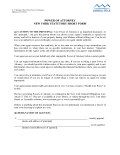 Judicial Title Statutory (Short-Form) Power of Attorney
Judicial Title Statutory (Short-Form) Power of Attorney
Download: PDF
Table of Contents |
Laws
Definition of “Durable”
A power of attorney is durable unless it expressly provides that it is terminated by the incapacity of the principal. (Gen. Oblig. Law § 1501A(1)).The subsequent incapacity of a principal shall not revoke or terminate the authority of an agent who acts under a durable power of attorney (Gen. Oblig. Law § 5-1501A(2)).
Definition of “Power of Attorney”
“Power of attorney” means a written document, other than a document referred to in section Gen. Oblig. Law § 1501C of this title, by which a principal with capacity designates an agent to act on his or her behalf and includes both a statutory short form power of attorney and a non-statutory power of attorney (Gen. Oblig. Law § 1501(J))
Signing Requirements
The principal and agent must have their signatures acknowledged by an authorized notary public. In addition, the principal’s signature must be witnessed by two persons who are not named in the instrument as agents or permissible gift recipients — one of whom may be the notary public acknowledging the document. (Gen. Oblig. Law §1501B.)
Statutory Form
The New York State legislature has created a sample statutory form for durable power of attorney available at Gen. Oblig. Law § 5-1513.
How to Write
Download: PDF, MS Word, OpenDocument
1 – The New York Documentation Necessary To Delegate Principal Power Is Available For Download Here
This page provides the required written tool an individual in New York will need to appoint another with the same Authority he or she has. Locate the caption area containing three buttons under the preview image then select the file version with which you intend to work.
2 – Deliver Some Required Material To Supplement Designation Statements
Every party involved with this delegation of Authority must be clearly identified by Name, Location, and Role. This task will be handled in Section “(B) Designation Of Agent(s).” The terminology necessary for a statement of declaration is presented in this area, however, it will need information pertaining to the situation at hand. Supplying this information will be a straightforward process. Each blank space in this section must have the information it requests supplied to it.  Begin by producing the Name of the Principal on the first available space. Make sure this is his or her Full Name – as it appears on his or her Identification Papers. The Principal’s Complete Mailing Address will also need to be supplied. Make sure this appears on the blank space after the words “. . .With A Mailing Address Of,” then complete this segment of the Principal report with the City where the Principal Mailing Address is located on the next available space.
Begin by producing the Name of the Principal on the first available space. Make sure this is his or her Full Name – as it appears on his or her Identification Papers. The Principal’s Complete Mailing Address will also need to be supplied. Make sure this appears on the blank space after the words “. . .With A Mailing Address Of,” then complete this segment of the Principal report with the City where the Principal Mailing Address is located on the next available space.  The Agent the Principal will give Principal Authority will need to be specifically named. Make sure to document this individual’s official First, Middle, and Last Name on the blank space after the words “. . .Hereby Appoint.”
The Agent the Principal will give Principal Authority will need to be specifically named. Make sure to document this individual’s official First, Middle, and Last Name on the blank space after the words “. . .Hereby Appoint.” 
In addition to the Agent’s Name, we must also record his or her Mailing Address and City. Furnish this information across the next two blank spaces.  This paperwork will contain the option to name multiple Agents. First, the Principal must document whether he or she intends to do so. If not, the Principal should initial the blank line placed to the left of the statement, which states “There shall be no other Agents.”
This paperwork will contain the option to name multiple Agents. First, the Principal must document whether he or she intends to do so. If not, the Principal should initial the blank line placed to the left of the statement, which states “There shall be no other Agents.”

If the Principal does intend to grant the right to wield his or her Authority to multiple Agents, then each one will have to be named and carry Principal Approval. In which case, the Name, Mailing Address, and City of the additional Agent must be supplied to the three blank spaces after the words “…Another Agent Known As” in the second statement. The Principal must initial this statement to approve this additional Agent.

If multiple Agents will be able to wield Principal Authority, it must be indicated how they must interact. If the Principal wishes each Agent to be able to use Principal Power without the consultation or approval of other Agents, then he or she must initial the line adjacent to “My agents may act SEPARATELY.” If each Agent may only act only after consulting and agreeing with the other Agents, then the Principal must leave this statement unmarked.

In Section “(C) Designation Of Successor Agent(s),” individuals can be named to be potential Agents in certain circumstances. That is, should the Agents named above not be able to wield Principal Powers then a Successor Agent will already have the documentation to assume this Authority as per the execution of this document. This can be considered a wise precaution in many instances. However, if the Principal does not wish to name any Successor Agents then, he or she should initial the statement “There shall be no Successor Agents.”

If the Principal does want to have Successor Agents set up here, the next two statements will allow for up to two (2) Successor Agents to be named. In this case, each Successor Agent’s Name, Mailing Address, and City must be named to a unique statement that is then initialed by the Principal. Only the Principal’s initials can approve the individual named in a statement be appointed with Principal Powers.

The Principal must now choose whether he or she wishes each Successor Agent to act with Authority only when all the Agents act together on an action. If they can only act jointly, the Principal may proceed to the next section. If each Successor Agent may act with autonomy, then the Principal must initial the statement “My Successor Agents may act SEPARATELY.”

An option to provide additional preferences the Principal may have regarding succession has been supplied in the last statement. If the Principal has any such instructions, they should be provided in detail using the blank space after the words “Insert specific succession provisions here.”
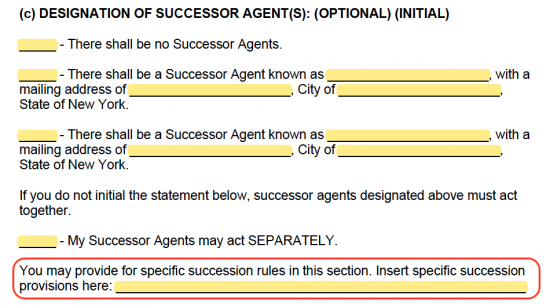
3 – Authority Is Granted With Approval Only The Principal Can Provide
The next area requiring interaction will be “(f) Grant Of Authority.” Here a comprehensive listing of the types of transactions the Principal can approve the Agent to conduct in his or her Name has been constructed. Each of these lettered items (A through O) where the Principal wishes to grant the Agent Authority should be initialed by the Principal. The Principal may initial any or all of these descriptions to delegate the Agent with the right to conduct Principal Business in the selected areas on behalf of the Principal.

If the Principal would prefer to list each item he or she wishes to grant the Agent (saving the trouble of initialing multiple times), then he or she can list each of the letter items the Agent can have Principal Authority over on the blank space after the words “. . . by the following letters” in item “(P).” After, the Principal must initial the blank line that precedes the letter “(P).”
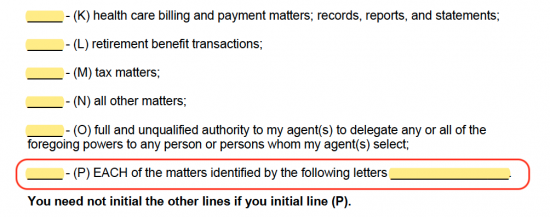
4 – Modifications To The Granted Powers Should Be Included And Approved If Applicable
Some additional optional items have been included in this paperwork to cover every contingency the Principal may wish to enact. We will begin dealing with these items by turning our attention to “(g) Certain Gift Transactions: Statuary Gifts Rider.” If the Principal has initialed “(I) Personal And Family Maintenance” and intends to attach the “Power Of Attorney New York Statutory Gifts Rider Authorization For Certain Gift Transactions” to this paperwork, then the Principal should initial the blank space in this section.

An additional section, “(h) Modifications,” has been included in this paperwork so any specific instructions the Principal has regarding the way this document operates can be detailed. For instance, the Principal may wish the Agent to have Principal Authority for only a specific time frame or the Principal may wish to revoke other Authority documents that have been previously issued. If so, such directives can be presented on the blank line under the heading “(h) Modifications.” If there are no such directives, then this area may be left blank or the word “None” should be placed on this line.

The next option provided will be to name a Monitor who will hold the Agent(s) accountable for all transactions conducted in the Principal’s Name through this document. If the Principal does wish to appoint a Monitor for this purpose, then he or she must record the Name of each Monitor on the blank space after the words “. . . I wish to designate . . .” and the Address of each Monitor on the line after the words “. . . whose address(es) is (are).” The Principal must initial the blank space preceding this statement to approve the Monitors named here. 
5 – The Principal Signature Will Serve As Both Acknowledgment And Proof Of Principal Intent
In order for this document to be considered a valid representation of the Principal’s intentions and wishes, he or she will need to supply a Dated and Notarized Signature. In “(m) Signature And Acknowledgment,” he or she will have to record the Calendar Date of the Signature as well as a Month, Calendar Day, and Calendar Year across the two blank spaces in the first statement of this section.  Below the Signature Date, the Principal must sign this document on the line labeled “Principal Signature.”
Below the Signature Date, the Principal must sign this document on the line labeled “Principal Signature.”  The area under the words “State Of New York County Of” is the notarization section that only a Notary Public present at the time of signing may satisfy.
The area under the words “State Of New York County Of” is the notarization section that only a Notary Public present at the time of signing may satisfy. 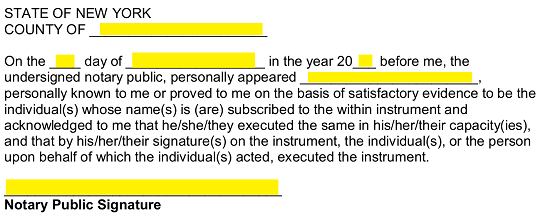
6- Two Witnesses Must Provide Acknowledgment of Principal’s Voluntary Intent
Under Section “(n) Signatures of Witnesses,” two persons, both of whom are not named in the instrument as agents or as permissible recipients of gifts, must Sign and Print their names, present their Addresses, and provide the Date of their acknowledgment.
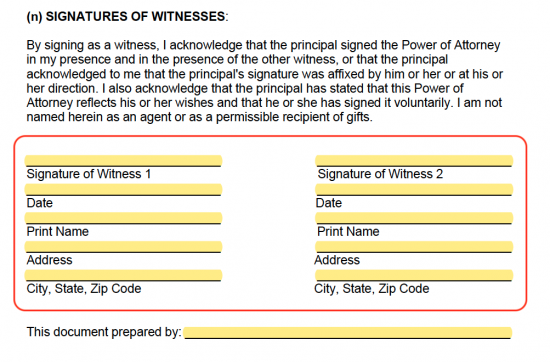
7 – A Signature Of Acknowledgment Is Also Required Of The Agent(s)
In addition to the Principal’s Acknowledgment Signature, the Agent will have to read Section “(o) Important Information For The Agent” and the subsequent item, Liability of Agent” Once the Agent has read these areas, each one must Print their Name on the blank line after the words “I/we,” which appears on Section “(p) Agent’s Signature and Acknowledgment of Appointment.” After, they must sign along the “Agent(s) Signature” line. If there is only one Agent, only one line needs to be signed.
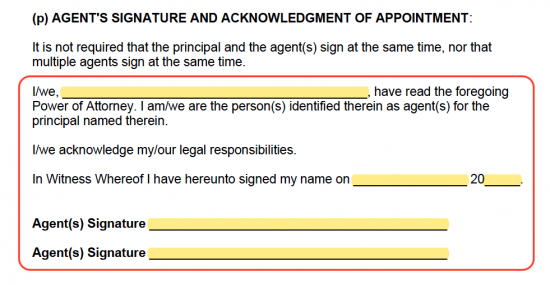
The Notary Public will populate the next area to notarize this document accordingly. 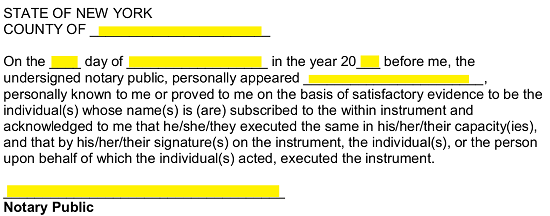
Successor Agents named in this document should read “(o) Important Information For The Agent” (this will relate directly to a Successor Agent if he or she assumes Principal Power), then each one must print their Name on the first blank line after the words “I/we” under Section “(q) Successor Agent’s Signature and Acknowledgment of Appointment.” Once these tasks have been completed, each Successor Agent must sign along the line labeled “Successor Agent(s) Signature.” 
The Notary Public serving the Successor Agent Signing will use the section below the signatures to notarize this signing. 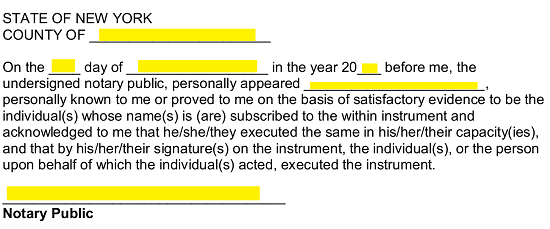
Related Forms
Download: PDF
Download: PDF, MS Word, OpenDocument

